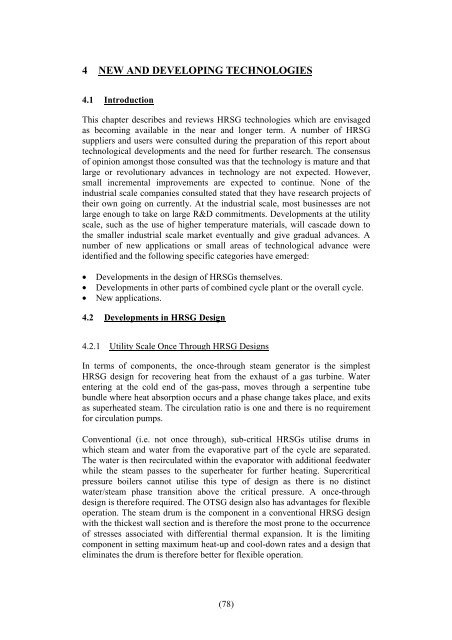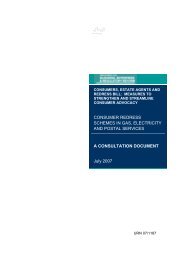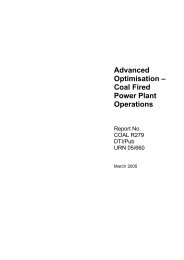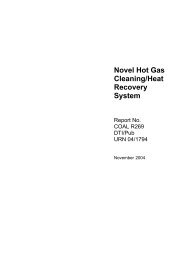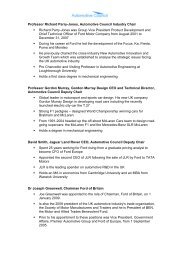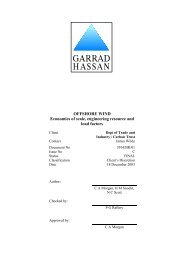(70) Therefore, the risk of sulphuric acid dew point attack ... - DTI Home
(70) Therefore, the risk of sulphuric acid dew point attack ... - DTI Home
(70) Therefore, the risk of sulphuric acid dew point attack ... - DTI Home
You also want an ePaper? Increase the reach of your titles
YUMPU automatically turns print PDFs into web optimized ePapers that Google loves.
4 NEW AND DEVELOPING TECHNOLOGIES<br />
4.1 Introduction<br />
This chapter describes and reviews HRSG technologies which are envisaged<br />
as becoming available in <strong>the</strong> near and longer term. A number <strong>of</strong> HRSG<br />
suppliers and users were consulted during <strong>the</strong> preparation <strong>of</strong> this report about<br />
technological developments and <strong>the</strong> need for fur<strong>the</strong>r research. The consensus<br />
<strong>of</strong> opinion amongst those consulted was that <strong>the</strong> technology is mature and that<br />
large or revolutionary advances in technology are not expected. However,<br />
small incremental improvements are expected to continue. None <strong>of</strong> <strong>the</strong><br />
industrial scale companies consulted stated that <strong>the</strong>y have research projects <strong>of</strong><br />
<strong>the</strong>ir own going on currently. At <strong>the</strong> industrial scale, most businesses are not<br />
large enough to take on large R&D commitments. Developments at <strong>the</strong> utility<br />
scale, such as <strong>the</strong> use <strong>of</strong> higher temperature materials, will cascade down to<br />
<strong>the</strong> smaller industrial scale market eventually and give gradual advances. A<br />
number <strong>of</strong> new applications or small areas <strong>of</strong> technological advance were<br />
identified and <strong>the</strong> following specific categories have emerged:<br />
• Developments in <strong>the</strong> design <strong>of</strong> HRSGs <strong>the</strong>mselves.<br />
• Developments in o<strong>the</strong>r parts <strong>of</strong> combined cycle plant or <strong>the</strong> overall cycle.<br />
• New applications.<br />
4.2 Developments in HRSG Design<br />
4.2.1 Utility Scale Once Through HRSG Designs<br />
In terms <strong>of</strong> components, <strong>the</strong> once-through steam generator is <strong>the</strong> simplest<br />
HRSG design for recovering heat from <strong>the</strong> exhaust <strong>of</strong> a gas turbine. Water<br />
entering at <strong>the</strong> cold end <strong>of</strong> <strong>the</strong> gas-pass, moves through a serpentine tube<br />
bundle where heat absorption occurs and a phase change takes place, and exits<br />
as superheated steam. The circulation ratio is one and <strong>the</strong>re is no requirement<br />
for circulation pumps.<br />
Conventional (i.e. not once through), sub-critical HRSGs utilise drums in<br />
which steam and water from <strong>the</strong> evaporative part <strong>of</strong> <strong>the</strong> cycle are separated.<br />
The water is <strong>the</strong>n recirculated within <strong>the</strong> evaporator with additional feedwater<br />
while <strong>the</strong> steam passes to <strong>the</strong> superheater for fur<strong>the</strong>r heating. Supercritical<br />
pressure boilers cannot utilise this type <strong>of</strong> design as <strong>the</strong>re is no distinct<br />
water/steam phase transition above <strong>the</strong> critical pressure. A once-through<br />
design is <strong>the</strong>refore required. The OTSG design also has advantages for flexible<br />
operation. The steam drum is <strong>the</strong> component in a conventional HRSG design<br />
with <strong>the</strong> thickest wall section and is <strong>the</strong>refore <strong>the</strong> most prone to <strong>the</strong> occurrence<br />
<strong>of</strong> stresses associated with differential <strong>the</strong>rmal expansion. It is <strong>the</strong> limiting<br />
component in setting maximum heat-up and cool-down rates and a design that<br />
eliminates <strong>the</strong> drum is <strong>the</strong>refore better for flexible operation.<br />
(78)


